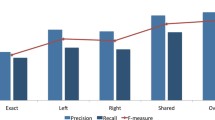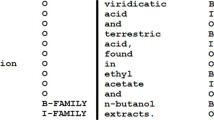Abstract—
The huge space of experimental data on biological and chemical objects and their interactions contributes to the rapid growth of scientific publications containing their analysis. Such data may include characteristics of low-molecular-weight compounds, results of their biological activity evaluation, and their interaction with human and animal proteins, methods of synthesis of organic compounds, and their classification. The past decades saw the development of methods for automated extraction of data from texts of scientific publications, including those for retrieval of names of organic compounds. These data can be used for the automatic identification of the names of organic compounds, including all possible synonyms. Since the topics of scientific publications are diverse, the extracted data can be applied to obtain information about (1) classification of organic compounds (2) methods of synthesis of a given organic compound; (3) physicochemical properties of this compound; (4) its interaction with high-molecular-weight compounds (including proteins, mRNA of animals and humans); and (5) the therapeutic properties of organic compounds, the active substance of the drug, and data on clinical trials. This review considers the methods aimed at searching and extracting data on names of low-molecular-weight compounds and interactions between them and animal and human proteins (biological objects), as well as data on experimentally confirmed biological activity and the effects of organic compounds (including drugs) on pathological processes. Here, we discuss the methods developed and the results of their application published over the past 10 years.


Similar content being viewed by others
REFERENCES
Krallinger, M., Rabal, O., Lourenço, A., Oyarzabal, J., and Valencia, A., Information retrieval and text mining technologies for chemistry, Chem. Rev., 2017, vol. 117, no. 12, pp. 7673–7761.
Przybyła, P., Shardlow, M., Aubin, S., Bossy, R., Eckart de Castilho, R., Piperidis, S., Mcnaught, J., and Ananiadou, S., Text mining resources for the life sciences, Database, 2016, vol. 2016, pp. 1–30.
Oellrich, A., Gkoutos, G.V., Hoehndorf, R., and Rebholz-Schuhmann, D., Quantitative comparison of mapping methods between human and mammalian phenotype ontology, J. Biomed. Semantics, 2012, vol. 3, no. s2/s1, pp. 1–10.
O’Mara-Eves, A., Thomas, J., McNaught, J., Miwa, M., and Ananiadou, S., Using text mining for study identification in systematic reviews: A systematic review of current approaches, Syst. Rev., 2015, vol. 4, no. 5, pp. 1–22.
Smink, W.A.C., Fox, J.-P., Tjong Kim Sang, E., Sools, A.M., Westerhof, G.J., and Veldkamp, B.P., Understanding therapeutic change process research through multilevel modeling and text mining, Front. Psychol., 2019, vol. 10, p. 1186.
PubMed. https://pubmed.ncbi.nlm.nih.gov/.
Krallinger, M., Rabal, O., Leitner, F., Vazquez, M., Salgado, D., Lu, Zh., Leaman, R., Lu, Y., Ji, D., Lowe, D.M., Sayle, R.A., Batista-Navarro, R.Th., Rak, R., Huber, T., Rocktäschel, T., et al., The CHEMDNER corpus of chemicals and drugs and its annotation principles, J. Cheminf., 2015, vol. 7, artic. no. S2.
khondi, S.A., Hettne, K.M., van der Horst, E., van Mulligen, E.M., and Kors, J.A., Recognition of chemical entities: Combining dictionary-based and grammar-based approaches, J. Cheminf., 2015, vol. 7, artic. no. S10
Li, J., Sun, Y., Johnson, R.J., Sciaky, D., Wei, C.-H., Leaman, R., Davis, A.P., Mattingly, C.J., Wiegers, T.C., and Lu, Z., BioCreative V CDR task corpus: A resource for chemical disease relation extraction, Database, 2016, vol. 2016, artic. no. baw086.
Wei, C.-H., Peng, Y., Leaman, R., Davis, A.P., Mattingly, C.J., Li, J., Wiegers, T.C., and Lu, Z., Assessing the state of the art in biomedical relation extraction: Overview of the BioCreative V chemical-disease relation (CDR) task, Database, 2016, vol. 2016, artic. no. baw032.
Madan, S., Szostak, J., Komandur Elayavilli, R., Tsai, R.T.-H., Ali, M., Qian, L., Rastegar-Mojarad, M., Hoeng, J., and Fluck, J., The extraction of complex relationships and their conversion to biological expression language (BEL) overview of the BioCreative VI (2019) BEL track, Database, 2019, vol. 2019, artic. no. baz084.
Martínez, V., Navarro, C., Cano, C., Fajardo, W., and Blanco, A., DrugNet: Network-based drug–disease prioritization by integrating heterogeneous data, Artif. Intell. Med., 2015, vol. 63, no. 1, pp. 41–49.
Herrero-Zazo, M., Segura-Bedmar, I., Martinez, P., and Declerck, T., The DDI corpus: An annotated corpus with pharmacological substances and drug–drug interactions, J. Biomed. Inf., 2013, vol. 46, no. 5, pp. 914–920.
Pérez-Pérez, M., Rabal, O., Pérez-Rodríguez, G., Vazquez, M., Fdez-Riverola, F., Oyarzabal, J., Valencia, A., Lourenço, A., and Krallinger, M., Evaluation of chemical and gene/protein entity recognition systems at BioCreative V.5: The CEMP and GPRO patents tracks, Proceedings of the BioCreative. Vers.5. Challenge Evaluation Workshop, 2017, pp. 11–18. https://b-iocreative.bioinformatics.udel.edu/media/store/files/2017/BioCreative_V5_paper2.pdf.
Bada, M., Eckert, M., Evans, D., Garcia, K., Shipley, K., Sitnikov, D., Baumgartner, Jr., W.A., Cohen, B., Verspoor, K., Blake, J.A., and Hunter, L.E., Concept annotation in the CRAFT corpus, BMC Bioinf., 2012, vol. 13, no. 161, pp. 1–10.
Kolarik, C., Klinger, R., Friedrich, C.M., Hofmann-Apitius, M., and Fluck, J., Chemical names: Terminological resources and corpora annotation, Workshop on Building and Evaluating Resources for Biomedical Text Mining (6th Edition of the Language Resources and Evaluation Conference), Marrakech, Morocco, 2008, pp. 51–58. https://pub.uni-bielefeld.de/record/2603498.
Cañada, A., Capella-Gutierrez, S., Rabal, O., Oyarzabal, J., Valencia, A., and Krallinger, M., LimTox: A web tool for applied text mining of adverse event and toxicity associations of compounds, drugs and genes, Nucleic Acids Res., 2017, vol. 45, no. W1, pp. W484–W489.
Swain, M.C. and Cole, J.M., ChemDataExtractor: A toolkit for automated extraction of chemical information from the scientific literature, J. Chem. Inf. Model., 2016, vol. 56, no. 10, pp. 1894–1904.
Batista-Navarro, R., Rak, R., and Ananiadou, S., Optimising chemical named entity recognition with pre-processing analytics, knowledge-rich features and heuristics, J. Cheminf., 2015, vol. 7, artic. no. S6.
Leaman, R., Khare, R., and Lu, Z., Challenges in clinical natural language processing for automated disorder normalization, J. Biomed. Inf., 2015, vol. 57, pp. 28–37.
Rocktäschel, T., Weidlich, M., and Leser, U., ChemSpot: A hybrid system for chemical named entity recognition, Bioinformatics, 2012, vol. 28, no. 12, pp. 1633–1640.
Campos, D., Bui, Q.-C., Matos, S., and Oliveira, J.L., TrigNER: Automatically optimized biomedical event trigger recognition on scientific documents, Source Code Biol. Med., 2014, vol. 9, no. 1, p. 1.
Lu, Z. and Hirschman, L., Biocuration workflows and text mining: Overview of the BioCreative 2012 Workshop Track II, Database, 2012, vol. 2012, artic. no. bas043.
Liu, H., Christiansen, T., Baumgartner, W.A., and Verspoor, K., BioLemmatizer: A lemmatization tool for morphological processing of biomedical text, J. Biomed. Semantics, 2012, vol. 3, no. 3, pp. 1–29.
Song, H.-J., Jo, B.-C., Park, C.-Y., Kim, J.-D., and Kim, Y.-S., Comparison of named entity recognition methodologies in biomedical documents, BioMed. Eng. OnLine, 2018, vol. 17, suppl. 2, pp. 158–192.
Halberstam, N.M., Baskin, I.I., Palyulin, V.A., and Zefirov, N.S., Neural networks as a method for elucidating structure-property relationships for organic compounds, Russ. Chem. Rev., 2003, vol. 72, no. 7, pp. 629–649.
Baskin, I.I., Madzhidov, T.I., Antipin, I.S., and Varnek, A.A., Artificial intelligence in synthetic chemistry: Achievements and prospects, Russ. Chem. Rev., 2017, vol. 86, no. 11, pp. 1127–1156.
Cho, H. and Lee, H., Biomedical named entity recognition using deep neural networks with contextual information, BMC Bioinf., 2019, vol. 20, no. 1, pp. 735–746.
Maheswaranathan, N., Williams, A.H., Golub, M.D., Ganguli, S., and Sussillo, D., Reverse engineering recurrent networks for sentiment classification reveals line attractor dynamics, Adv. Neural Inf. Process. Syst., 2019, vol. 32, pp. 15696–15705.
Li, Z., Gurgel, H., Dessay, N., Hu, L., Xu, L., and Gong, P., Semi-supervised text classification framework: An overview of dengue landscape factors and satellite earth observation, Int. J. Environ. Res. Public Health, 2020, vol. 17, no. 12, pp. 4509–4538.
Kaewphan, S., Hakala, K., Miekka, N., Salakoski, T., and Ginter, F., Wide-scope biomedical named entity recognition and normalization with CRFs, fuzzy matching and character level modeling, Database, 2018, vol. 2018, artic. no. bay096.
Campos, D., Matos, S., and Oliveira, J.L., A document processing pipeline for annotating chemical entities in scientific documents, J. Cheminf., 2015, vol. 7, artic. no. S7.
Korvigo, I., Holmatov, M., Zaikovskii, A., and Skoblov, M., Putting hands to rest: Efficient deep CNN-RNN architecture for chemical named entity recognition with no hand-crafted rules, J. Cheminf., 2018, vol. 1, p. 28.
Luo, L., Yang, Z., Yang, P., Zhang, Y., Wang, L., Lin, H., and Wang, J., An attention-based BILSTM-CRF approach to document-level chemical named entity recognition, Bioinformatics, 2018, vol. 34, no. 8, pp. 1381–1388.
Hemati, W. and Mehler, A., LSTMVoter: Chemical named entity recognition using a conglomerate of sequence labeling tools, J. Cheminf., 2019, vol. 11, no. 3, pp. 1–7.
Lung, P.-Y., He, Z., Zhao, T., Yu, D., and Zhang, J., Extracting chemical–protein interactions from literature using sentence structure analysis and feature engineering, Database, 2019, vol. 2019, artic. no. bay138.
Capuzzi, S.J., Thornton, T.E., Liu, K., Baker, N., Lam, W.I., O’Banion, C.P., Muratov, E.N., Pozefsky, D., and Tropsha, A., Chemotext: A publicly available web server for mining drug–target–disease relationships in PubMed, J. Chem. Inf. Model., 2018, vol. 58, no. 2, pp. 212–218.
Mao, Y. and Lu, Z., MeSH Now: Automatic MeSH indexing at PubMed scale via learning to rank, J. Biomed. Semantics, 2017, vol. 8, no. 1, pp. 15–24.
Ponomarenko, E.A., Lisitsa, A.V., Il’gisonis, E.V., and Archakov, A.I., Construction of protein semantic networks using PubMed/MEDLINE, Mol. Biol., 2010, vol. 44, pp. 140–149.
Vempati, U.D. and Schurer, S.C., Development and applications of the bioassay ontology (BAO) to describe and categorize high-throughput assays, in Assay Guidance Manual, Markossian, S., Sittampalam, G.S., Grossman, A., et al., Bethesda: Eli Lilly & Company and the National Center for Advancing Translational Sciences, 2004, pp. 1045–1069.
Hastings, J., Chepelev, L., Willighagen, E., Adams, N., Steinbeck, Ch., and Dumontier, M., The chemical information ontology: Provenance and disambiguation for chemical data on the biological semantic web, PLoS ONE, 2011, vol. 6, no. 10, p. e25513.
Funding
The study was financed by the Russian Science Foundation (project no. 19-15-00396).
Author information
Authors and Affiliations
Corresponding authors
Ethics declarations
The authors declare that they have no conflicts of interest.
About this article
Cite this article
Biziukova, N.Y., Tarasova, O.A., Rudik, A.V. et al. Automatic Recognition of Chemical Entity Mentions in Texts of Scientific Publications. Autom. Doc. Math. Linguist. 54, 306–315 (2020). https://doi.org/10.3103/S0005105520060023
Received:
Published:
Issue Date:
DOI: https://doi.org/10.3103/S0005105520060023




